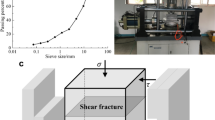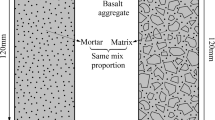Abstract
Triaxial loading tests were carried out on the gangue-based haydite concrete cube specimens (100 × 100 × 100 mm3) and plate specimens (100 × 100 × 50 mm3) to investigate the mechanical behavior of this kind of lightweight aggregate concrete (LWAC) under multi-axial stress state, and accordingly to develop the failure criterion for the finite element analysis of LWAC structures. Experimental results revealed that, under triaxial compression loading, most of the haydites within the specimen were crushed when the stress ratios σ 1/ σ 3 ≥ 0.3 and σ 2/ σ 3 ≥ 0.5. The gangue haydite concrete exhibited “plastic flow plateau” at this stage, which was conservatively regarded as the ultimate strength of the LWAC under triaxial compressive stress state. As a result, the tensile and compressive meridians on failure envelope surface are intersected with hydrostatic axial at two points, completely different from the characteristics of normal weight concrete for which the failure surface is unclosed and open-ended under compression. In terms of the test data, a four-parameter triaxial failure criterion for LWAC was developed. The strength envelope in the deviatoric plane adopted elliptic curve similar to that of Willam–Warnke model, and the tensile and compressive meridians were represented by quadratic functions with four parameters. Two alternative methods, i.e. the characteristic strength points method and the least square regression method, were used to determine the model parameters. After compared with the failure criterion recommended by fib Model Code 2010, methods proposed in this study are preferred especially when the plastic flow property is taken into account.




















Similar content being viewed by others
References
Tachibana D, Imai M, Okada T (1990) Qualities of high-strength lightweight concrete used for construction of arctic offshore platform. J Offshore Mech Arct Eng 112(1):27–34
FIB Model Code for Concrete Structures (2010) fib Bulletin 65, fib, Ernst & Sohn
Cui HZ, Lo TY, Memon SA, Xing F, Shi X (2012) Analytical model for compressive strength, elastic modulus and peak strain of structural lightweight aggregate concrete. Constr Build Mater 36:1036–1043
Alexandre BJ, Gomes A (2013) Compressive behavior and failure modes of structural lightweight aggregate concrete-characterization and strength prediction. Mater Des 46:832–841
Ergul Y, Cengiz DA, Alaettin K (2003) Strength properties of lightweight concrete made with basaltic pumice and fly ash. Mater Lett 57(15):2267–2270
Melby K, Jordet EA, Hansvold C (1996) Long-span bridges in Norway constructed in high-strength LWA concrete. Eng Struct 18(11):845–849
Jo BW, Park SK, Park JB (2007) Properties of concrete made with alkali-activated fly ash lightweight aggregate (AFLA). Cem Concr Comp 29(2):128–135
Haug AK, Fjeld S (1996) A float concrete platform hull made of lightweight aggregate concrete. Eng Struct 18(11):831–836
Rossignolo JA, Agnesini MVC, Morais JA (2003) Properties of high-performance LWAC for precast structures with Brazilian lightweight aggregates. Cem Concr Comp 25(1):77–82
Li QB, Ansari F (2000) High-strength concrete in triaxial compression by different sizes of specimens. ACI Mater J 97(6):684–689
Hampel T, Speck K, Scheerer S, Ritter R, Curbach M (2009) High-performance concrete under biaxial and triaxial loads. J Eng Mech 135(11):1274–1280
Swaddiwudhipong S, Seow PEC (2006) Modelling of steel fiber-reinforced concrete under multi-axial loads. Cem Concr Res 36(7):1354–1361
Sirijaroonchai K, El-Tawil S, Parra-Montesinos G (2010) Behavior of high performance fiber reinforced cement composites under multi-axial compressive loading. Cem Concr Comp 32(1):62–72
He ZJ, Song YP (2010) Triaxial strength and failure criterion of plain high-strength and high-performance concrete before and after high temperatures. Cem Concr Res 40(1):171–178
Taylor MA, Jain AK, Ramey MR (1972) Path dependent biaxial compressive testing of an all-lightweight aggregate concrete. ACI J Proc 69(12):758–764
Atan Y, Slate FO (1973) Structural lightweight concrete under biaxial compression. ACI J Proc 70(3):182–186
Hussein A, Marzouk H (2000) Behavior of high-strength concrete under biaxial stresses. ACI Mater J 97(1):27–36
Song YP, Zhao GF, Peng F, Shen JN (1996) Strength of lightweight concrete under triaxial compression. China Ocean Eng 10(2):239–244
Liu HY, Song YP (2010) Experimental study of lightweight aggregate concrete under multiaxial stresses. J Zhejiang Univ Sci A 11(8):545–554
Ries JP, Speck J, Harmon KS (2010) Lightweight aggregate optimizes the sustainability of concrete through weight reduction, internal curing, extended service life, and lower carbon footprint. In: Proceedings of the International Concrete Sustainability Conference, Dubai, United Arab Emirates, December 2010, p 15
Dehn F (2004) Fracture mechanical behaviour of lightweight aggregate concrete. In: Proceedings of the 5th International Conference on Fracture Mechanics of Concrete and Concrete Structures (FraMCos-5), vol 2, Vail, CO, USA, April 2004, pp 1097–1104
Kupfer H, Hilsdorf H, Rusch H (1969) Behavior of concrete under biaxial stresses. ACI J Proc 66(8):656–666
Song YP (2002) The constitutive model and failure criterion of concrete materials. China Water Power Press, Beijing
Fan SC, Wang F (2002) A new strength criterion for concrete. ACI Struct J 99(3):317–326
Willam KJ, Warnke EP (1975) Constitutive model for the triaxial behavior of concrete. In: Proceedings of the International Association for Bridge and Structural Engineering. Bergamo, Italy, 19: p 1–30
Acknowledgments
This study was supported by the National Natural Science Foundation of China (Grant No. 51378090) and the Open Research Fund of State Key Laboratory of Simulation and Regulation of Water Cycle in River Basin (China Institute of Water Resources and Hydropower Research) with Grant Number of IWHR-SKL-201309.
Author information
Authors and Affiliations
Corresponding author
Rights and permissions
About this article
Cite this article
Wang, Lc., Song, Yp. Mechanical behavior and failure criterion of the gangue-based haydite concrete under triaxial loading. Mater Struct 48, 1419–1433 (2015). https://doi.org/10.1617/s11527-013-0243-x
Received:
Accepted:
Published:
Issue Date:
DOI: https://doi.org/10.1617/s11527-013-0243-x




